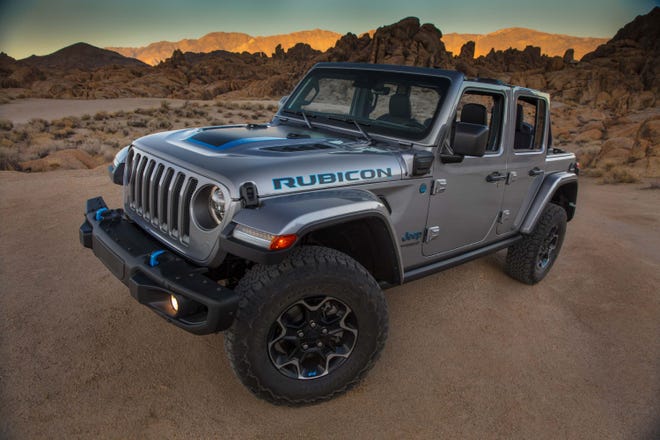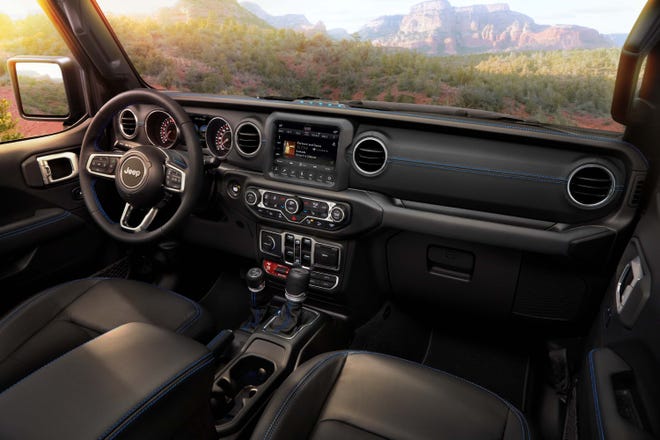Debut: Jeep Wrangler 4xe plug-in hybrid promises smooth rock-crawling
Posted by Talbot Payne on September 3, 2020
The long-awaited Jeep Grand Wagoneer SUV is coming back, and that’s not the off-road brand’s only new offering.
The 2021 Jeep Wrangler 4xe plug-in that debuted Thursday is a greener, more-premium version of the brand’s iconic dirt-kicker. Just as the Grand Wagoneer offers a teak-trimmed alternative to gold-plated Range Rovers, the 4xe is aimed at the lifestyles of the rich and adventurous.
The Wrangler 4xe will mate twin electric motors to a 2.0-liter turbo 4-cylinder gasoline engine for a combined 375 horsepower and stump-pulling 470 pound-feet of torque. The system claims about 400 miles of hybrid range with a towing capability of up to 3,500 pounds. The 4xe will get a claimed 25 miles on its 17-kWh battery alone.
Offered only in upscale 4xe, Sahara and Rubicon trims, the Wrangler 4xe will start well north of the standard $29,790 Wrangler. Gas-powered Rubicon and Sahara trims start at about $40,000 and fully loaded models can push $60,000. Expect 4xe models to climb even higher. Prices will be announced as the 4xe comes to market in the US, Europe and China next year.

Just as Wrangler defines Jeep’s off-road ethic, so will the 4xe wear a green halo. It will lead a Jeep march of 30 electrified vehicles in the next few years as manufacturers strain to meet stringent government emissions mandates. At the premium end of the market where sleek EVs like the Tesla Model Y have gained traction, the 4xe plug-in offers a rugged choice without range anxiety..
Electric Blue will be the 4xe’s signature.

The unique color will trace Jeep badges as well as the Rubicon name on the hood. Electric Blue Rubicon tow hooks stand out against black bumpers. Inside, Electric Blue stitching highlights seats and trim in the 4xe Rubicon.
The Wrangler 4xe is armed for the Outback with a ladder frame, trail-rated gear, solid front and rear axles, full-time 4×4 two-speed transfer case, articulating suspension and 30 inches of water-fording capability (with the battery sealed under the rear seat to prevent damage).
Buttons left of the steering wheel control three modes of its “E Selec” energy-storage system.
- eSave: Saves the battery for pure-EV off-roading or in urban areas (like European cities) were gas engines are banned.
- Electric: The Wrangler operates on battery alone until the powertrain reaches minimum charge or the driver’s heavy right foot requests more torque (such as wide-open throttle) from the gas engine.
- Hybrid: The default hybrid mode combines the 2.0-liter engine and electric motors.
Jeep promises that treacherous off-road maneuvers will be smoother in eSave mode using the vehicle’s torquey electric motors.
“The Wrangler 4xe offers a more precise off-road driving experience with no traditional transmission torque converter,” said Wrangler engineer Mike Weissich. Translation: The electric motors smoothly apply torque as opposed to a gas engine where the driver has to rev the engine to roll over rocky terrain.
Credit a new motor generator, replacing the conventional generator, that spins the engine for nearly seamless, fuel-saving start-stop operation and generates electricity for the battery pack. A second generator is mounted at the front of the transmission case, replacing the conventional torque converter of an automatic transmission.
Typical of electrified vehicles, the 4xe regenerates the battery when the driver uses the brakes. The blue Wrangler amps up that capability with a “Max Regen” feature which applies more assertive regenerative braking calibration when the vehicle detects the driver’s foot is completely off the throttle.
Whether drivers paying $60,000 for an SUV will want to risk off-road scratches is an open question. But if they just want to use the 25 miles EV range around town, the battery will fully recharge in about 12 hours on a standard household outlet.


